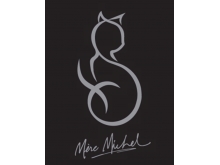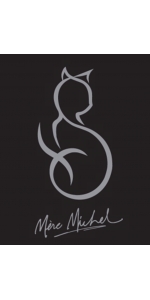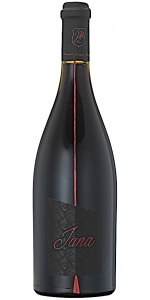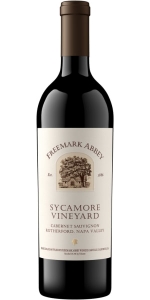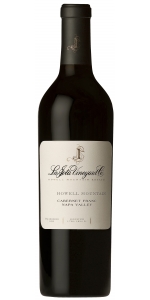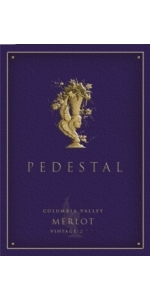Johann Michel Cornas Cuvee Mere Michel 2017 (magnum)
| Country: | France |
| Regions: | Rhone Cornas |
| Winery: | Johann Michel |
| Grape Type: | Syrah |
| Vintage: | 2017 |
| Bottle Size: | 1500 ml |
Johann Michel Cornas Cuvee Mere Michel is made from 100 percent Syrah.
Cuvee Mère Michel was first introduced in 2016 and is not produced every year. This wine is a tribute to Johann Michel' wife, Emmanuelle, and a nod to the French song, La Mere Michel. This wines comes from Selection Massale (replanting new vineyards with cuttings from exceptional old vines from the same property) cuttings of Serine off the 1947 Yves Cuilleron vineyard at Chavanay. The vineyards are located in the lieu-dit "Les Cotes" at an altitude of 230 meters and benefiting from a southern sun exposure.
Review:
"Only made in top vintages, the 2018 Cornas Mère Michel is a tribute to Johann's wife and a play on the French song "La Mere Michelle." Brought up in a new demi-muid, it's a richer, broader wine compared to the Cuvée Jana yet still has incredible Cornas style in its red, black, and blue fruits as well as notes of toasted spice, roasted meat, chocolate, and wild herbs. Rich, full-bodied, and opulent, it has a touch more upfront appeal and should be drinkable in just 4-5 years yet also evolve for two decades." -
Jeb Dunnuck (Northern Rhône: The 2018s and 2019s, November 19th 2020), 98 pts
Johann Michel Cornas Cuvee Mere Michel is made from 100 percent Syrah.
Cuvee Mère Michel was first introduced in 2016 and is not produced every year. This wine is a tribute to Johann Michel' wife, Emmanuelle, and a nod to the French song, La Mere Michel. This wines comes from Selection Massale (replanting new vineyards with cuttings from exceptional old vines from the same property) cuttings of Serine off the 1947 Yves Cuilleron vineyard at Chavanay. The vineyards are located in the lieu-dit "Les Cotes" at an altitude of 230 meters and benefiting from a southern sun exposure.
Review:
The tiny production 2022 Cornas Mère Michel is 100% Serine that was not destemmed and was aged 14 months in French oak. Tighter and more focused, this beautiful wine reveals ripe red and blue fruits that give way to more spice, leather, graphite, and mineral notes. More medium to full-bodied, with a firm spine of tannins, it's impressive but will need time.
-Jeb Dunnuck 94 Points
Johann Michel Cornas Cuvee Jana is 100% Syrah.
Black raspberry aromas, licorice, sizzled bacon and smoke. Elegant and pure with depth and well-integrated tannins.
Jana is the name of Johann and Emmanuelle's daughter.
Manual harvest, selection of the grapes from the "Chaillot" parcel, full clusters, fermentation in tanks for 3 weeks, daily remontage and pigeage. Malolactic fermentation in oak barrels and aging on the lees for 12-18 months in barrels (new old barrels) The average age of the vines is 11 years. Yield: 25 hl/ha
Review:
"Dark purple. Highly perfumed, oak-spiced black and blue fruits, incense, vanilla and potpourri on the hugely perfumed nose, along with hints of licorice, smoked meat and mocha. Stains the palate with concentrated, spice-laced blueberry, cassis, cherry-vanilla and espresso flavors that turn sweeter as the wine opens up. Broad, polished tannins add shape to a strikingly long, smoke- and spice-driven finish that strongly echoes the floral and blue fruit notes. - Josh Raynolds"
- Antonio Galloni's Vinous (December 2022), 97 pts
Johann Michel Cornas Cuvee Jana is 100% Syrah.
Black raspberry aromas, licorice, sizzled bacon and smoke. Elegant and pure with depth and well-integrated tannins.
Jana is the name of Johann and Emmanuelle's daughter.
Manual harvest, selection of the grapes from the "Chaillot" parcel, full clusters, fermentation in tanks for 3 weeks, daily remontage and pigeage. Malolactic fermentation in oak barrels and aging on the lees for 12-18 months in barrels (new old barrels) The average age of the vines is 11 years. Yield: 25 hl/ha
Review:
Johann Michel Cornas is 100% Syrah
This Cornas is a blend from 2 different vineyard sites:
- 60% of the final blend is from vineyards located on a hillside (16 year old vines on the "coteau"), planted on sandy soils, decomposed granite and some rocks, giving the structure, spiciness and licorice flavors to the blend.
- the other 40% of the final blend comes from the bottom of the slope (40 years old vines on the "pied de coteau"), planted on sandy soils, bringing acidity and balance to the wine.
Expressive, deep, rich, silky and juicy. Well structured and round, it displays red fruit, leather, black cherry, liquorice and black berry aromas.
Review:
"Bright and intense both in color and in aroma. Hyper-fresh, searching berry fruits, this is electric. Rounded, with plump berry fruits that are concentrated and fresh. The tannins are intense too, grippy and strict on the long finish. This is almost painful to taste at this stage, but should be excellent in time. Vines with an average of 35 years of age, from lieux-dits Saveaux, Patou and Les Côtes, all destemmed and then aged in two- to five-year-old demi-muids. - Matt WALLS"
- Decanter (Rhone 2021 en primeur, October 1st 2022), 96 pts
Johann Michel Cornas is 100% Syrah
This Cornas is a blend from 2 different vineyard sites:
- 60% of the final blend is from vineyards located on a hillside (20 year old vines on the "coteau"), planted on sandy soils, decomposed granite and some rocks, giving the structure, spiciness and licorice flavors to the blend.
- the other 40% of the final blend comes from the bottom of the slope (45 years old vines on the "pied de coteau"), planted on sandy soils, bringing acidity and balance to the wine.
Expressive, deep, rich, silky and juicy. Well structured and round, it displays red fruit, leather, black cherry, liquorice and black berry aromas.
Review:
"Ripe black and blue fruits, violets, sappy herbs, and iron notes all emerge from the 2022 Cornas, a pretty, pure, medium to full-bodied Cornas offering fine, ripe tannins, a balanced, layered mouthfeel, and a great finish. The 2022 was completely destemmed and spent 12 months in oak."
- Jeb Dunnuck (Importer Highlight: Fran Kysela ; July 2024), 93 pts
Johann Michel Cornas Cuvee Mere Michel is made from 100 percent Syrah.
Cuvee Mère Michel was first introduced in 2016 and is not produced every year. This wine is a tribute to Johann Michel' wife, Emmanuelle, and a nod to the French song, La Mere Michel. This wines comes from Selection Massale (replanting new vineyards with cuttings from exceptional old vines from the same property) cuttings of Serine off the 1947 Yves Cuilleron vineyard at Chavanay. The vineyards are located in the lieu-dit "Les Cotes" at an altitude of 230 meters and benefiting from a southern sun exposure.
Review:
"A new cuvée (at least for me), the 2017 Cornas Mere Michel comes from sandy, granite-laced soils and was brought up in new demi-muids. It's largely in the same mold as the traditional cuvée yet has another level of richness, depth, and texture. Blackcurrants, scorched earth, graphite, burning embers, and a kiss of bloody meat all flow to a rich, powerful Cornas that has ultra-fine tannins, beautiful mid-palate depth, and a great, great finish. It's unquestionably a candidate for the wine of the vintage in Cornas. Bravo!"
- Jeb Dunnuck (December 12th 2019), 98 pts
The Domaine Johann Michel Estate
Johann Michel is a self-taught winemaker who discovered his passion while tasting old bottles of wine with his grandfather. His first vintage was 1997. He works alongside his wife Emmanuelle, farming a little over 5.5 hectares (13.5 acres) spread between three AOC’s:
- 4 hectares are in Cornas, all farmed under "culture raisonnée" (sustainable method), in the lieux dits "Les Côtes", "Bayonnet", "Chaillot" and the parcel called "Saveaux" for the AOC Cornas. Yields are very low here – 33 hl/ha for Cornas Tradition and 25 hl/ha for Cuvee Jana. He also produces a special cuvée, only in certain years: “Cuvée de la Mère Michel”, a tribute to his wife & a play on the French song “La Mere Michelle”.
AOC Cornas is one of the smallest AOC’s in France (only 116.4 hectares; 287 acres) - 0.37 hectares in Saint Joseph AOC. Planted only with Syrah, Johann’s first vintage was 2016 with 700 bottles produced. The vineyard is 120 meters high in altitude with a density of the density of 4,400 vines per hectare. The Saint Joseph wine is made using 100% destemmed grapes.
Saint Joseph AOC is quite large compared to Cornas AOC, with a total acreate around 920 hectares (2,270 acres). The quality of the soils can be very different from one part to the appellation to another part of the AOC. - 1 hectare in Saint Peray, planted with Marsanne and Roussanne. His parcels are located at the extreme South of the Saint Peray AOC (a few meters away from the border with the Cornas AOC). Johann makes 2 cuvées of Saint Peray: Saint Peray Blanc (a blend of 50% Roussanne and 50% Marsanne), and Saint Peray Blanc Cuvée M (100% Marsanne).
The nose opens with aromas of blackberry, blueberry, black current and boysenberry. The fruit elements are complimented with notes of forest floor, cigar box, dark chocolate and espresso. The wine is rich and balanced and French oak barrels add the ideal amount of complexity with notes of baking spice and warm vanilla. This is a full-bodied wine with integrated tannins that give it a long, lingering finish. Stunning.
Primary Vineyard: Sycamore Vineyard—Rutherford (100%): Small 24-acre vineyard located about 1.2 miles south of Bosche, right up against the Mayacamas Range, this vineyard has a rich clay loam. Sycamore Vineyard produces small berries reminiscent of mountain fruit berries, with intense extract of color and flavor. The color is very dark early in the fermentation, with flavors of black currant and black berry with a forest floor complexity.
Review:
Mint, spearmint, dark-berry and blueberry aromas. Leaves and sage, too. Full-bodied and firm with fantastic depth. Cool fruit with menthol and mint. Spice. Refreshing. Firm tannins. Fantastic 2017. Drink or hold.
-James Suckling 97 Points
Inglenook Rubicon is made from 88% Cabernet Sauvignon, 8% Merlot, 3% Cabernet Franc, 1% Petit Verdot
Since its inaugural vintage in 1978, Rubicon has been the Estate's premier red wine, reflecting the soul of the property and expressing Francis Coppola's wish to create a Bordeaux-styled grand wine, that is, "a wine that can please contemporary taste, but with a historical aspect [that defines] our vineyards at their zenith."
Rubicon was named after the small river crossed by Julius Caesar in 49 B.C., declaring his intention to gain control of Rome, thereby launching a civil war among opposing factions. Over time the phrase "crossing the Rubicon" has come to signify any irreversible action with revolutionary intent or the outcome of which holds great risk. True to its uncommon depth, Inglenook's Rubicon continues to be a testament to the finely tuned rendering of a risk well-taken.
Strikingly rich in color and extract, the 2018 Rubicon is unquestionably a precocious, hedonistic wine. The exotic, well-knit aromas and flavors include ripe cassis, allspice, star anise, vanilla and black licorice. Upon entry, this full-bodied wine envelops the palate with its luxurious concentration and supple, silky tannins, supported by vibrant freshness from the balanced acidity, and perfectly-integrated French oak. Very long and expansive in the finish, the 2018 Rubicon will be memorable for decades to come.
Review:
Subtle and complex red with blackberry, black truffle, sweet tobacco and mahogany. Highlights of lavender and violets. Full-bodied and very tight with finesse and tension. Very polished, fine tannins. Long finish. Delicious already, but best after 2022.
-James Suckling 97 Points
La Jota Howell Mountain Cabernet Franc is made from 100% Cabernet Franc.
The 2019 Cabernet Franc opens with aromas of cassis and graphite when poured in the glass. The firm tannins set the stage on the palate melded with rich flavors of boysenberry and pain de grille with a silky mouthfeel and lingering finish.
Review:
Savory in black pepper, smoked meat and cigar box, this wine is high-toned aromatically, with lovely hints of violet and dried herb, sage and bay leaf. Mountain-sturdy tannins give it structure, power and room to age, with lasting acidity to keep it fresh. Enjoy best from 2029–2039
.-Wine Enthusiast 95 Points
Michel Rolland, Pomerol vintner and consultant to many of the world's top wineries, teamed with Washington State wine visionary Allen Shoup to produce this limited release wine.
With its intense color and inviting aromas of dark berries, licorice, baking spice and a hint of smoke, the Pedestal is a bold wine that leaves a lasting impression. Dark fruit flavors integrated with sweetness from the barrel and richness from the tannins come together seamlessly, lingering across a structured mid-palate and lengthy finish.
Winemaking: Hand-harvested grapes were double-sorted to remove green material that might impart harsh tannins, then most of the lots were cold soaked to build richness and flavor before undergoing whole-berry fermentation in 55L upright French wood tanks. This, combined with gentle pump-overs throughout fermentation, enhanced the wine’s color, texture and mouthfeel. The finished wine was aged 22 months in 85% new French oak barrels.
Review:
"I loved the 2014 Pedestal Merlot and it’s 81% Merlot, 15% Cabernet Sauvignon, 2% Malbec and 2% Petit Verdot. It offers a downright voluptuous and incredibly sexy style in its ripe black currants, toasted spice, chocolate and licorice aromas and flavors. Broad, expansive, layered and pleasure bent, with ripe tannin, it's a knockout Merlot that's going to have 10-15 years of drinkability. - Jeb Dunnuck"
- Robert Parker's Wine Advocate (Issue #231, June 2017), 95 pts
Long Shadows Pedestal Merlot 2016 is made from 75% Merlot, 21% Cabernet Sauvignon, and the rest Petit Verdot.
Michel Rolland, Pomerol vintner and consultant to many of the world's top wineries, teamed with Washington State wine visionary Allen Shoup to produce this limited release wine.
With its intense color and inviting aromas of dark berries, licorice, baking spice and a hint of smoke, the Pedestal is a bold wine that leaves a lasting impression. Dark fruit flavors integrated with sweetness from the barrel and richness from the tannins come together seamlessly, lingering across a structured mid-palate and lengthy finish.
Winemaking: Hand-harvested grapes were double-sorted to remove green material that might impart harsh tannins, then most of the lots were cold soaked to build richness and flavor before undergoing whole-berry fermentation in 55L upright French wood tanks. This, combined with gentle pump-overs throughout fermentation, enhanced the wine’s color, texture and mouthfeel. The finished wine was aged 22 months in 85% new French oak barrels.
Review:
"The 2016 Pedestal from Michel Rolland checks in as a blend of 75% Merlot, 21% Cabernet Sauvignon, and the rest Petit Verdot that spent 22 months in 85% new French oak. It has a rocking bouquet of smoked black fruits, espresso, chocolate, and tobacco that gives way to a full-bodied, plump, incredibly sexy red that does everything right. It's one serious mouthful of Merlot and should keep for 10-12 years." - Jeb Dunnuck (April 2019), 95 pts
"The 2016 Pedestal Merlot has a precise nose of dusty plum, red flowers and soft oak tones with an elegant aroma of pencil lead fluttering about. The medium to full-bodied palate is clean and correct, with plush dark red fruit, dusty tannins, purple flowers and soft oak spices of vanilla, cardamom and nutmeg. The wine ends with a long, thoughtful, well-balanced finish that delivers complexity and pleasure simultaneously. Michel Rolland made this beauty of a bottle. - Anthony Mueller"
- Robert Parker's Wine Advocate (Issue #246, December 2019), 94 pts
Long Shadows Pedestal Merlot is made from 82% Merlot, 14% Cabernet Sauvignon, and 4% Malbec.
Michel Rolland, Pomerol vintner and consultant to many of the world's top wineries, teamed with Washington State wine visionary Allen Shoup to produce this limited release wine.
With its intense color and inviting aromas of dark berries, licorice, baking spice and a hint of smoke, the Pedestal is a bold wine that leaves a lasting impression. Dark fruit flavors integrated with sweetness from the barrel and richness from the tannins come together seamlessly, lingering across a structured mid-palate and lengthy finish.
Winemaking: Hand-harvested grapes were double-sorted to remove green material that might impart harsh tannins, then most of the lots were cold soaked to build richness and flavor before undergoing whole-berry fermentation in 55L upright French wood tanks. This, combined with gentle pump-overs throughout fermentation, enhanced the wine’s color, texture and mouthfeel. The finished wine was aged 22 months in 85% new French oak barrels.
Review:
Vinous 96 Points
"The 2016 Pedestal Merlot has a precise nose of dusty plum, red flowers and soft oak tones with an elegant aroma of pencil lead fluttering about. The medium to full-bodied palate is clean and correct, with plush dark red fruit, dusty tannins, purple flowers and soft oak spices of vanilla, cardamom and nutmeg. The wine ends with a long, thoughtful, well-balanced finish that delivers complexity and pleasure simultaneously. Michel Rolland made this beauty of a bottle. - Anthony Mueller"
- Robert Parker's Wine Advocate (Issue #246, December 2019), 94 pts
- back
All older vintage wines have been purchased from a single collectors cellar. Pictures can be requested before shipment.
Carra Beaujolais Blanc Pierres Dorees is made from 100 percent Chardonnay.
The nose shows step by step floral and fruity aromas. A vanilla hint in the end with a lingering finish: those are typical Chardonnay aromas.

